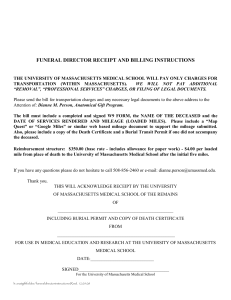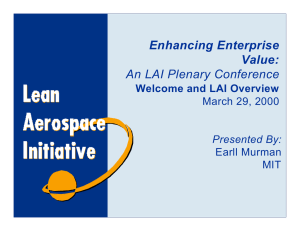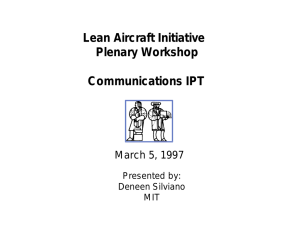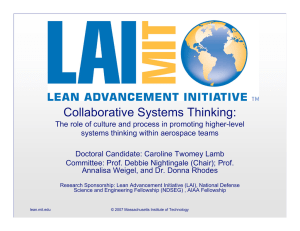Creating Value Across The Enterprise Enhancing Enterprise Value:
advertisement
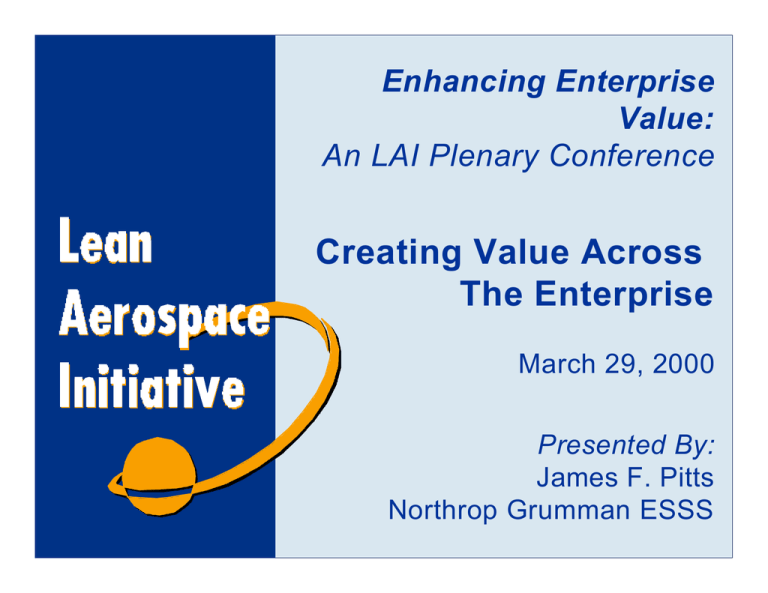
Enhancing Enterprise Value: An LAI Plenary Conference Creating Value Across The Enterprise March 29, 2000 Presented By: James F. Pitts Northrop Grumman ESSS Overview ➣ LAI Executive Roundtable Background ➣ Value in the Enterprise ➣ The Setting for Aerospace in the New Millennium ➣ Five Perspectives on Value ➣ Common Themes ➣ The Vision for the Future ➣ Next steps PP Pitts032900 - 2 © 2000 Massachusetts Institute of Technology LAI Executive Board Roundtable Background ➣ Objective ➢ Provide LAI Executive Board members the opportunity to contribute to the framing of the LAI Phase III research agenda ➢ Use the value perspective to identify key issues facing the defense aerospace enterprise ➣ Attendees ➢ LAI Executive Board ➢ Invited senior government and industry leaders ➣ Outcomes ➢ Position paper: “Value Across the Enterprise” ➢ Edited video ➢ “Next Steps” recommendations PP Pitts032900 - 3 © 2000 Massachusetts Institute of Technology Why Value? ➣ Lean is about delivering value to the customer using only what is needed to do so ➣ A cornerstone of lean transformations is the value stream analysis—identifying the steps and processes that create value for the customer ➣ The first step in the transition to the lean enterprise is understanding value across the enterprise ➢ Who benefits from value—value from the multiple enterprise customers’ perspectives ➢ Who contributes value—the processes and steps that create value for those customers PP Pitts032900 - 4 © 2000 Massachusetts Institute of Technology A Context for the Value Discussion Product Value Definition: Value is a measurement of the worth of a specific product or service by a customer, and is a function of (1) the product’s usefulness in satisfying a customer need, (2) the relative importance of the need being satisfied, (3) the availability of the product relative to when it is needed and (4) the cost of ownership to the customer ➣ Value in the enterprise is more than just product value (e.g., “the right thing at the right time at the right price”) ➣ It involves: ➢ Maintaining focus on the “right customer” ➢ Assembling and managing the “right enterprise” of partners ➢ Attracting and retaining the “right people” ➢ Using the “right technology” to provide best lifecycle value PP Pitts032900 - 5 © 2000 Massachusetts Institute of Technology Setting for Aerospace in the New Millennium ➣ The third industrial revolution ➢ Major new technologies are driving the creation of economic wealth (e.g., computers, telecom, biotech, etc.) ➢ Economic value creation and profitability is shifting away from traditional manufacturing to these new technology sectors ➢ Globalization is producing globally-interdependent economies ➣ Post-cold war threat environment ➢ Nation states breaking apart at an accelerated pace ➢ Political and economic instability leading to armed conflict ➢ Threats both proliferating and diversifying At a time when innovation in product value delivery is needed, the defense aerospace enterprise is struggling to attract and retain capital and talent PP Pitts032900 - 6 © 2000 Massachusetts Institute of Technology Perspectives on Value Representing Five Major Enterprise Stakeholders ➣ Investment Community—Wolfgang Demisch, Managing Director, Wasserstein Perella Securities ➣ Organized Labor—Robert V. Thayer, General Vice President, International Association of Machinists and Aerospace Workers ➣ Industry—Daniel P. Burnham, Chairman & CEO, The Raytheon Company ➣ Acquisition Community—Darleen A. Druyun, Principal Deputy Assistant Secretary of the Air Force For Acquisition And Management, United States Air Force ➣ Warfighter—Gen. Richard B. Myers, USAF, Commander-in-Chief, North American Aerospace Defense Command, United States Space Command, and Air Force Space Command; Department of Defense Manager for Manned Space Flight Support Operations PP Pitts032900 - 7 © 2000 Massachusetts Institute of Technology Investment Community Perspective ➣ Investors’ values are like warfighters’ values—they want higher performance at lower costs ➣ Unprecedented bull market during the last 20 years has shaped investor expectations ➣ Aerospace satisfies investor values in some areas PP Pitts032900 - 8 © 2000 Massachusetts Institute of Technology Labor Perspective ➣ Labor values quality of life, a voice in the enterprise ➣ Union members have the most to lose from the implementation of lean practices ➣ Union members desire a voice in developing solutions to the challenges facing industry (and affecting them) PP Pitts032900 - 9 © 2000 Massachusetts Institute of Technology Industry Perspective ➣ Industry values are a composite of its many stakeholders: ➣ The primary customer (the military) is becoming more responsive to the financial needs of the industry, but the “cost-plus-a-small-profit” mindset still prevails ➣ Meeting investors’ demands is immediate concern for many defense sector firms because low valuation impacts investment in future capability PP Pitts032900 - 10 © 2000 Massachusetts Institute of Technology Acquisition Community Perspective ➣ Acquisition community values providing capability to the warfighter at the lowest cost ➣ Recent program experience has shown the benefit of analyzing value to build a business case ➣ Distrust is the primary barrier to widespread adoption of demonstrated successful practice PP Pitts032900 - 11 © 2000 Massachusetts Institute of Technology Warfighter Perspective ➣ Warfighter values the “right capability” at the “right time” ➢ Advanced technologies are the key to providing the needed capabilities ➣ Many challenges ➢ Currently takes too long to field systems, including an overlylong requirements generation process ➢ Costs are too high ➢ Commercial technology still doesn’t always meet warfighter requirements, especially at the system level ➢ Even more difficult challenge than private sector to recruit and retain the talented people needed to operate the systems ➣ Partnerships between (and within) government and industry are the key to overcoming these challenges ➢ Government hasn’t always treated all partners as equal in past PP Pitts032900 - 12 © 2000 Massachusetts Institute of Technology Common Themes ➣ Challenge to recruit and retain talent ➣ Need more stability (financial, employment, etc.) ➣ Need to integrate fragmented processes, create partnerships, align the enterprise ➣ Perhaps the most common theme was that there are many very different, focused perspectives ➢ “The value I want”—most common subject ➢ “The value I contribute”—occasional mention ➢ “The value we create together”—emerging awareness PP Pitts032900 - 13 © 2000 Massachusetts Institute of Technology Vision of the Future ➣ Objective: provide total customer solutions through a close strategic partnership between customer and contractor ➣ The enterprise must have: ➢ The financial strength to maintain adaptable and responsive capability ➢ The economic and intellectual attractiveness to attract and retain intellectual capital Incentives within the enterprise must be designed to produce the desired outcomes PP Pitts032900 - 14 © 2000 Massachusetts Institute of Technology Conclusions ➣ A focused discussion using the value perspective provided important insights ➢ Enterprise-level challenges ➢ Future courses of action ➣ This is a first step on the pathway to a lean US defense aerospace enterprise ➢ Continue dialog on enterprise value and value stream ➢ Identify and implement remedies to the key challenges (financial strength, intellectual capital) ➢ Provide research findings to support dialog and implementation PP Pitts032900 - 15 © 2000 Massachusetts Institute of Technology Next Steps ➣ Continue and expand national-level dialog on these important issues ➣ LAI Executive Board base next roundtable on one of the key topics raised at last roundtable ➢ Financial strength/ Intellectual capital ➣ LAI draw on the key themes to inform and guide research in research teams PP Pitts032900 - 16 © 2000 Massachusetts Institute of Technology




